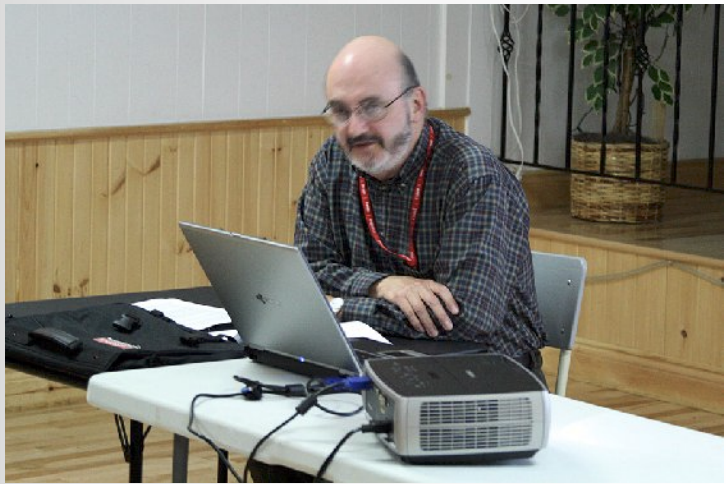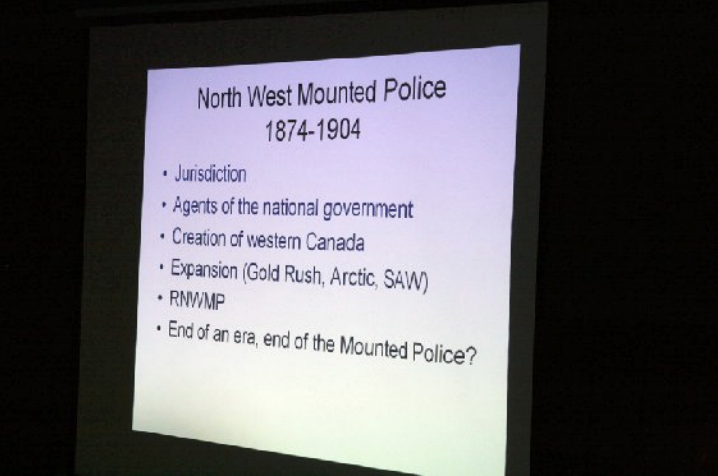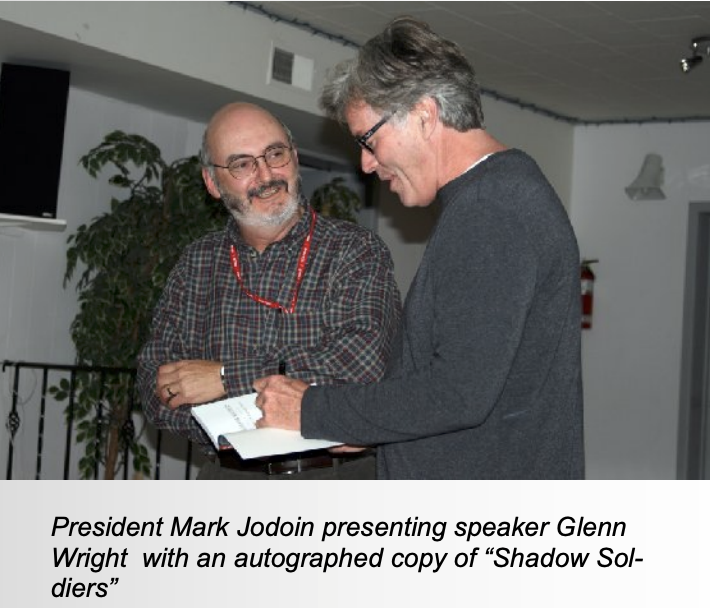Exploring the RCMP
Presentation to RTHS by Glenn Wright, October, 2009. Presentation report by Lucy Martin.
September’s meeting took place at Pierce’s Corners, in a lovely hall that has its own story. Stuart Rogers gave us a thumbnail sketch: the building was built in 1855 for £140 ($700) on Gallagher Road, before being dragged to the present site.
In time, it was declared surplus and nearly burned as an exercise for the fire department. But community members rallied in the 1970’s, rescuing the hall for continued use. Most recent improvements include a kitchen, better bathrooms and new flooring. (It’s a nice space, worth knowing about and using.)
The building held memories for many in the audience, including former area Mayor and MP Bill Tupper. It was there Tupper reported enduring “the worst night of my political life”, appearing with 5 rivals for office before an audience stirred up by a controversial article in the Kemptville Advance (which he had yet to read), all while battling a fever of 103.
Tupper survived the fever and the election. He noted the hall still housed the same humble wooden table where officials for Marlborough Township once conducted the business of governance. The building also hosted a party to commemorate the RTHS’s 25th anniversary.
Marguerite Rogers introduced the guest speaker, her friend, Glenn Wright. Wright retired in 2006 after a 30- year career as an archivist and historian with Library and Archives Canada, National Defense and the RCMP. His current activities include research for print and TV, writing and presentations that further his long-standing interest in the field of genealogy. The speaker offered his thanks to Leslie Anderson for her help and attendance at the presentation.

Wright began by observing an anniversary coincidence: just as the RTHS is marking its 35th year, it was 35 years ago to the very week that women first began their training as RCMP officers.
Wright did not wish to comment on RCMP controversies of today. His focus was the broad over-view of an iconic and truly Canadian institution, part of Sir John A. Macdonald’s vision and legacy of a law-abiding country from sea, to sea, to sea.
Interesting details: until fairly recent times, all RCMP recruits had to be able to ride. Equestrian training was discontinued as an economy measure in 1966. (Side note: The world-famous musical ride is still performed by actual RCMP personnel. Each year approximately 800 apply, 45 of whom are selected for 3-years of special duty.)
Institutional chronologies can be a dull affair: lists of dates, buildings, names, titles and a maze of organizational charts. Wright’s lively talk was well-spiced with the individuals and quirks that make history a dynamic adventure. Appropriate slides were enhanced by his wry observations.

For example, it turns out that Don Cherry’s grandfather, John Cherry, left Kingston as a young man of 18 to be among the first recruits headed west. On the TV show Who Do You Think You Are? some years ago, Don Cherry took great pleasure in reading his ancestor’s short record of service, including several sizable fines for breeches of discipline. (Unscientific evidence that insolence may be hereditary?)
Wright also gave a nod to the defunct and largelyforgotten Dominion Police, whose duties included intelligence work, and providing security for politicians and visiting royalty before being merged into an expanding and newly re-named RCMP in 1920.
The establishment of RCMP administrative offices in Ottawa included aspects of city geography, as well as the eternal and unending bureaucratic questions of who gets much-contested space. It even touches the Catholic Church after Archbishop Alexandre Vachon’s costly architectural aspirations lead instead to the RCMP – finally – gaining a single dedicated headquarters in Ottawa. In 1952, the RCMP initially rented the complex Vachon had envisioned as a grand seminary. Though at first denied the right to make alterations, the force eventually added facilities for forensics and computers to keep pace with investigative advances.
The politics of where to house economically significant job sites continues with the much-discussed RCMP move to the former JDS campus near Barrhaven.
The creation and evolution of the RCMP is a complex and interesting topic, naturally reflecting growth and change in Canada at large.
A red-coated Mountie may be the icon most associated with Canada, featured from comics to movies and on 13 Canadian stamps, so far. More information can be found at the RCMP’s website:
As always, we thank our guest speaker for sharing specialized knowledge with attendees.
(Editors note) One of the surprises for some of us was that what we now call the Royal Canadian Mounted Police was a late coming name. The missions and names of earlier versions of the RCMP went through several iterations before reaching the present day form.

Some western provinces had their own provincial police forces in earlier days but then disbanded them in favour of having the RCMP do the job for them. The slide below shows one earlier version. It didn’t even include the word “royal”.

